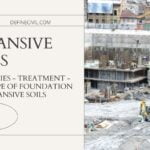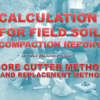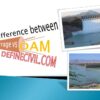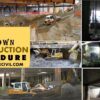A pile foundation is primarily a type of deep foundation that is a long-cylindrical column that transfers the building or structure’s load deep inside the earth to firm strata. There’re different types of pile foundation to suit the site or load situation.
Based on the construction methodology, we know following types of pile foundations:
- Bored Piling
- Driven Piling
- Screw Piling
- Sheet Piling.
- Mini Piling
But there’re many other types based on the material, and bearing or design. So, in our today’s blog we’ll discuss what is pile foundation, why we need a pile foundation, and different types of pile foundation.
Why we need a pile foundation?
Foundation is the most important and most critical part of any structure. All loads from a structure are transferred to the foundation which ultimately transfers loads to the ground.
There are two primary factors which a foundation has to fulfill;
- it should safely carry loads without failing in shear,
- it should not settle beyond prescribed limits.
Also Read: Foundation Failure – (Read it before its TOO Late)
The criteria of shear strength is checked using bearing capacity of soil and foundation is designed accordingly.
For settlement, separate studies are conducted and foundation is designed accordingly. Apart from these two factors, there are other important factors also which govern the selection and design of foundation.
Following are these factors:
- Soil index properties
- Type of soil
- Proximity of ground water table
- Frost line
- Presence of expansive soils, like, black cotton soil
- Economical aspects
Foundations are divided into two types with respect to depth i.e. shallow foundation and deep foundation.
Shallow foundation is the one which has depth less than or equal to its width. Shallow foundations are used when adequate bearing capacity and suitable soil parameters are available at a shallow depth.
Deep foundation is the one which has depth greater than its width. Deep foundations are used when adequate bearing capacity and other relevant soil parameters are not available at a shallow depth. Therefore, we have to go deep to reach suitable soil strata.

Pile Foundation
Pile foundation falls under the category of deep foundation.
A pile foundation is a series of columnar elements that are inserted into the ground to transfer loads to a greater depth.A pile is a long, slender, and vertical load transferring member constructed of either concrete, steel, or timber.
In pile foundation, a number of piles are driven into the base of the structure. Pile foundations are driven through the overburden soils into load bearing strata.
Generally, pile foundations are used when there is no firm strata available at near depth. It usually transfer loads through skin friction in case of friction piles or through bearing in case of end bearing piles. However, loads can be transferred through combination of both skin friction and end bearing. Pile foundations are placed at great depths.
Pile cap is an essential component of pile foundation. It is a thick concrete mat that is placed on piles that have been driven into the ground. Pile cap groups piles together and increases the stability. It ensures uniform load distribution.

Also Read: Pier Foundation – Post – Pier – Types
When to Use Pile Foundation?
Pile foundations are used under following conditions:
- When the soil at which the structure is to rest is compressible.
- When ground water table is high. Pile foundation is an excellent choice to resist uplift forces.
- When loads are uneven.
- When structures are massive and the underlying soil is not suitable to carry those loads.
- When the soil around the foundation is susceptible to erosion due to water action. This situation may arise when the structure is near some natural water body. Pile foundations offer better resistance to erosion.
- When load distribution is not uniform due to unevenness in the structure. In this case differential settlement might occur. Pile foundations are suitable for such conditions.
- When there are chances of differential settlement due to soil liquefaction, pile foundations prove to be a good choice.
- For earth and water retaining structures, pile foundations are used to resist lateral forces.
- Pile foundations are commonly used for massive structures like bridges.
Types of pile foundation
Pile foundations are classified based on their function and material and composition.
Types of pile foundation Based on Function
Piles based on the function or use may be classified as follows:
Bearing Piles
The piles which do not support the load by themselves, but act as a medium to transfer loads from the foundation to the resisting sub-strata, are called bearing piles. Bearing piles serve as transition between weak soil strata and hard soil strata.
The bottom end of the piles rest on load bearing strata which has adequate bearing capacity and adequate resistance to settlement.
Thus, piles act as columns carrying loads from weaker strata above to firm strata at great depth. Bearing piles get most of their strength because of their proper support on the strong soil layer at the end of pile.
The end of the pile needs to be penetrated into strong soil strata at sufficient depth to achieve maximum bearing. Usually, this penetration depth is taken as three times the diameter of the pile.

Friction Piles
Friction piles, also called floating piles, resist structural loads by developing skin friction around the surface of piles and the soil the piles are in contact with. Skin friction develops as the result of adhesion or friction between the surface of pile and the surrounding soil.
In other words, the friction of soil around the pile is what holds the pile in place. Friction piles are driven in soils where strength does not increase with depth or where the rate of increase in strength with depth is very slow.
Friction piles are specifically useful in situations when firm strata is too deep that the use of end bearing piles becomes unfeasible. As far as type of soil is concerned, friction piles are commonly used in areas where sandy soils are available at greater depths.
Friction piles are commonly used in skyscrapers where the soil encountered for foundation is mostly sandy.
One problem that might occur while using skin friction piles is of negative skin friction. Negative skin friction occurs when the soil surrounding the pile is settling.
Due to settlement, the skin friction which is supposed to act in vertical direction against loads, acts in downward direction, and the bearing capacity is reduced. Due measures need to be taken to prevent development of negative skin friction.
Sheet Piles
Sheet piles are used as bulk heads or impervious cut off to reduce seepage and uplift under hydraulic structures. These piles are not meant to carry any vertical load. Sheet piles are commonly used in hydraulic structures such as, weirs, barrages, falls, etc.
These are usually placed at the upstream and downstream side of a hydraulic structure to increase the seepage length and reduce the seepage pressure acting on the structure. Sheet piles are also used for the construction of temporary water retaining structures such as cofferdams. These are also used to prevent erosion of riverbanks and retain soil at its place. Sheet piles are made of wood, steel, or concrete.

Compaction Piles
The piles which are driven in granular soils to compact them into a denser state, are called compaction piles. The main purpose of compaction piles is to increase the bearing capacity of the soil through compaction.
Batter Piles
Batter piles are driven at an inclination to resist horizontal or inclined forces. These are always places at a certain angle with the horizontal to resist lateral or inclined forces. These are commonly used in structures which are subject to overturning moments due to wind, and waves. These are also used to support towers, bridges, and offshore structures.
Classification Based on Material, Composition and Method of Construction
Piles are generally classified as driven piles and bored piles. Driven piles are those which displace the soil for their placement. These are penetrated into the soil to required depths. Bored piles are those in which soil is replaced for their placement.
Soil is first removed and then piles are constructed in bores. In case of in-situ concrete piles, steel cage (if required according to design) is first installed in the bore and then concrete is poured.
On the basis of material, composition, and method of construction, piles are divided into several categories.
Concrete Piles
Concrete piles may be pre-cast piles and cast-in-situ piles.
Pre-cast concrete piles
The pre-cast concrete piles are usually reinforced concrete or pre-stressed concrete piles. Generally, the length of pre-cast concrete piles varies from 4m to 30m.
The pre-stressed concrete piles as compared to pre-cast reinforced piles are usually light in weight, easy to handle, and have high load carrying capacity.
Cast-in-situ Concrete Piles
The cast-in-situ concrete piles are usually of two types; driven piles and bored piles. We have already discussed the difference between driven piles and bored piles.
The cast-in-situ driven piles are further divided into two types i.e. cased and uncased piles. Cased piles are constructed by driving a metallic case/metallic shell into the ground and concrete is pured into that metallic shell. The metallic shell is made of steel. The common types of cased cast-in-situ piles are; Raymond piles, Mac-Arthur piles, and sewage piles.
Cased concrete piles
Cased cast-in-situ piles are suitable for all ground conditions.
Uncased Concrete Piles
Uncased concrete piles are those in which the metallic shell that was driven into the ground is removed before concreting. The common types of uncased cast-in-situ concrete piles are; simplex piles, Vibro Piles, and Pedestal piles. All these piles are used in different situations according to design requirements.
Simplex Piles:
It can be used in both soft and hard soils.
Vibro Piles
It is used where soft ground is encountered and there is little resistance to the flow of concrete.
Pedestal Piles
Pedestal piles are used where thin bearing strata is available at a reasonable depth. The pedestal at the end of pile gives the effect of spread footing and distributes loads over a wide area.
Also Read: Pile Driving Analysis Test (PDA Pile Testing)[With PICTURES]
Steel Piles
Steel piles are available in different shapes and different grades of steel. Steel piles may be either H-piles, circular (tube like) piles, or box piles (square, rectangular, or octagonal shape). These types are used in different situations according to design requirements. H-piles are driven piles. These are driven in hard soil strata at required depths where adequate bearing capacity is achieved. These piles are commonly used in retaining walls as these can withstand large lateral forces.
Box piles are used in hard strata where it is not feasible to use H-piles. Box piles offer sufficient frictional resistance to loads.
Also Read: Use of Bentonite Slurry in Pile Foundation
Timber Piles
Timber piles usually have a cast iron shoe at the bottom. Cast iron shoe facilitates installation and protects pile end from deterioration. Timber piles are available in square and circular cross-section. The size of square and circular pile may vary between 12″ to 20″.
It is common practice to keep the length of timber pile less than 20 times its top width. The ideal spacing of timber piles is about 90 cm.

Also Read: Cantilever footing – Strap Footing – Uses – Design – Difference
Composite Piles
Composite piles are those which are made up of two different materials which are usually driven one above the other. Commonly used composite piles are of timber and concrete, or steel and concrete.

Disc Piles
A disc pile consists of a hollow cast iron pipe with a disc or casing of enlarged size at the bottom. The casing is enlarged at the bottom to enlarge the bearing area to a great extent.
These piles are particularly useful if sub-soil is composed of sand or sandy silt. It is also used in marine structures. The size of disc piles varies from 60 cm to 120 cm.
Further Read: 5 Types of footing – Best footing – Images – Uses [PDF]




















